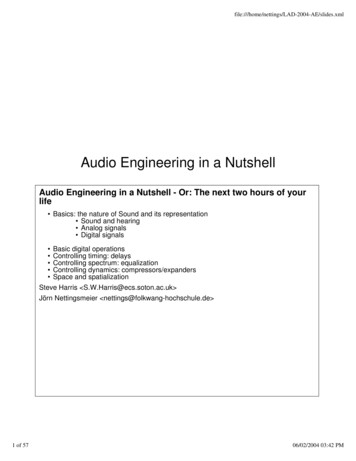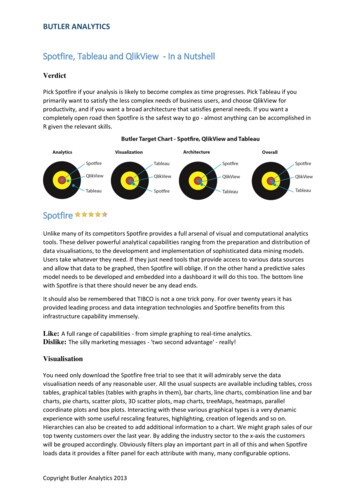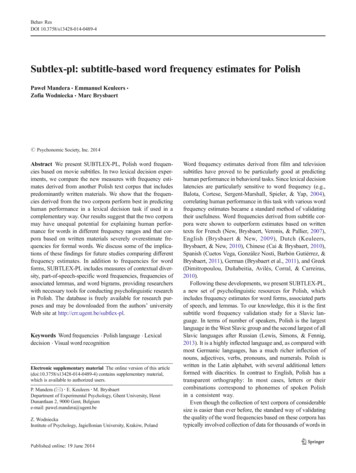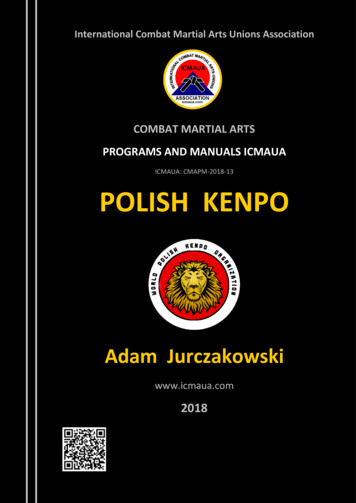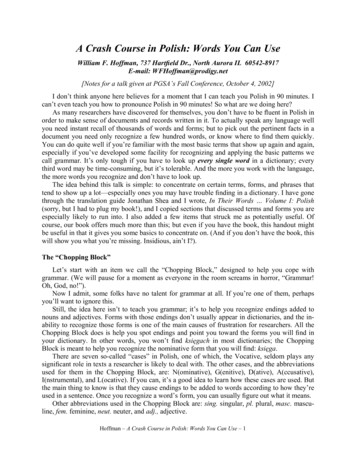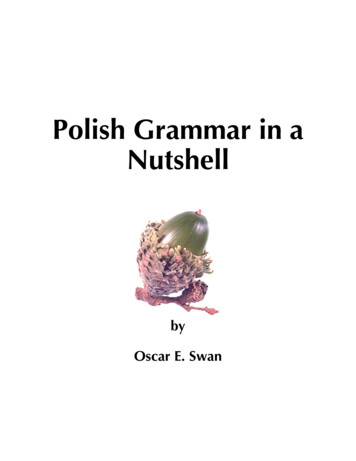
Transcription
Polish Grammar in aNutshellbyOscar E. Swan
2
Introduction 5Table of Contents1. The Polish Alphabet and Sounds 7Sound Values of the LettersNotes on Spelling and Pronunciation2. Nouns 11PreliminariesCases and Case UseChart of Regular Noun EndingsSupplements3. Pronouns 32Personal PronounsPossessive PronounsDemonstrative and Relative PronounsIntensive PronounsReflexive PronounsDistributive Pronouns4. Adjectives 38Adjective DeclensionAdjective-Noun OrderComparison of AdjectivesAdjective Opposites and Their Comparatives5. Adverbs 43Formation of AdverbsNon-Adjectival AdverbsNotes6. Numerals 47Cardinal NumeralsCollective NumeralsReified NumeralsIndefinite NumeralsOrdinal Numerals7. Prepositions 58English-to-Polish PrepositionsPolish-to-English PrepositionsPrepositions According to the Case Required3
8. Conjunctions 66Expressing If then 9. Verbs 68The InfinitiveFinite Verb CategoriesPragmatic Personal Verb CategoriesPresent TenseImperativePast TenseCompound Future TensePerfective and Imperfective AspectVerbs of MotionConditional MoodParticiples, Gerunds, Verbal NounsPassive VoiceDepersonal VerbsReflexive Verbs10. Important Sentence Constructions 91Constructions Using the InfinitiveModal ExpressionsIntroducing SentencesIdentity SentencesExpressing There IsPredicate Nouns and AdjectivesYes-No QuestionsNegationWord OrderSentence Intonation4
IntroductionPolish Grammar in a Nutshell is intended for use as a short reference and reviewgrammar at any level of Polish language study, from beginning to advanced. It can beused in conjunction with any of various curently available textbooks, or as a grammaticalaccompaniment to reading and translation courses. It covers sounds, spelling,pronunciation, conjugation and declension, verb aspect, adverbs, prepositions,conjunctions, the numeral and participle systems, and the basics of Polish syntax. As awhole, it summarizes the amount of grammar usually covered in a four-yearundergraduate Polish program at the college level.For current and continually updated information on Poland— its people, geography,politics, economy, and so on, consult the orld-factbook/geos/pl.htmlAbbreviations Occasionally Used Here1p, 2p, )imperimpf1st, 2nd, 3rd personaccusative caseadjectiveanimateadverbcomparativeconditional moodconjunctiondative casefeminine genderformal style usagegenitive caseinstrumental caseimperativeimperfective pfplpronsgsuperlV(oc)vb5infinitiveinformallocative casemasculine gendermasculine personal plural gendernominative caseneuter genderperson, personalperfective aspectpluralpronounsingularsuperlativevocative caseverb
Poland, its neighbors, and its major cities.6
1. The Polish Alphabet and SoundsHere is the Polish alphabet: a, ą, b, c, ć, d, e, ę, f, g, h, I, j, k, l, ł, m, n, ń, o, ó, p, r, s, ś,t, u, w, y, z, ź, ż.Sound Values of the LettersLetterApproximate English Sound Examplesaąfatherdometak thus, so, yes, raz oncesą they are, wąż snakeThe sound ą is pronounced like om, except that the lips or tongue are not completelyclosed to pronounce the m, leaving a nasal resonance instead.bbicchbigbeautifulfitshallbok side, aby so thatbieg course, run, race, tobie to youco what, noc night, taca traychata cottage, ucho ear, dach (roofThe sound of ch is much raspier and noisier than English h.ciczćcheekchalkcheek sciasto cake, cicho quietczas time, gracz player, tęcza rainbowchoć although, nićmi thread--Inst. pl.The letters ć and ci- are pronounced the same. The combination ci- is used before avowel. The letter c before i is pronounced like ć/ci-. The sound of ć/ci-, pronounced withthe mouth in the position of English y, is different from that of cz, pronounced with themouth in the position of English r.ddzdzidźdżdooddsjeansjeansjawdata date, lada countercudzy foreign, wodze reinsdziadek grandfather, ludzie peoplewiedźma witch, ludźmi people--Instr.pldżez jazz, radża rajahThe letters dź and dzi- are pronounced the same. The combination dzi- is used before avowel. The letters dz before i are pronounced like dź/dzi-. The sound of dź/dzi-,pronounced with the mouth in the position of English y, is different from that of dż,pronounced with the mouth in the position of English r.eęeversenseten this (masc.), ale but, Edek Eddiegęś goose, tęsknić long forThe sound ę is pronounced like em, except that the lips or tongue are notcompletely closed to pronounce the m, leaving a nasal resonance instead. At the7
end of a word, the letter ę is normally pronounced the same as e: naprawdę"naprawde".ffeltfarba paint, lufa rifle-barrel, blef bluffggetguma rubber, noga leg, footgiaguegie da stock-market, magiel manglehhallhak hook, aha aha!Pronounced the same as ch (see above), the letter h appears mainly in words offoreign origin.ijkkil mimnnińcheekyou, boykeglike youlovewag, bowharm youmothnotcanyoncanyonlist letter, ig a needlejak as, raj paradise, zając harekot cat, rok year, oko eyekiedy when, takie such (neut.)las forest, dal distance, fala wave eb animal head, by he was, o ówek pencilmiara measure, ziemia earthmama mama, tom volumenoc night, pan sir, ono itnie no, not, nigdy neverkoń horse, hańba disgraceThe letters ń and ni- are pronounced the same. The combination ni- is used before avowel. The letter n before i is pronounced like ń/ni-.oópoketootpot sweat, osa wasp, okno windowból pain, ołówek pencilThe letter ó is pronounced the same as u.ppirpupstop youarriba (Spanish)pas belt, strap, łapa paw, cap billy-goatpiana foam, łapie he catchesrada advice, kara punishment, dar (giftThe sound r is pronounced by trilling the tip of the tongue, as in Spanish, Italian, orRussian. However, it is less strongly trilled than in these languages.rzpleasurerzeka river, morze seThe letter-combination rz is pronounced the same as ż, more or less as in pleasure; seebelow.ssiszśsadsheepsharksheepsam (the same)--masc., pas (belt), rasa (breed)siano hay, sito sieveszal frenzy, dusza souoś axle, kwaśny sour, śpi he sleepsThe letters ś and si- are pronounced the same. The combination si- is used before a vowel.The letter s before i is pronounced like ś/si-. The sound of ś/si-, pronounced with the8
mouth in the position of English "y", is different from that of sz, pronounced with themouth in the position of English am there, data date, kot catbut shoe, tu here, ucho earwata cotton wadding, kawa coffeedym smoke, ty you--sg.zupa soup, faza phaseziarno grain, zima winterwyraźny distinct, źle (badlyżaba frog, plaża beachThe letters ê and zi- are pronounced the same. The combination zi- is used before avowel. The letter z before i is pronounced like ź/zi-. The sound of ź/zi-, pronounced withthe mouth in the position of English "y", is different from that of ż/rz, pronounced withthe mouth in the position of English "r".Notes on Spelling and Pronunciation1. The Polish alphabet has no q, v, or x, although these letters may be found intranscriptions of foreign names, and in a few borrowed words, e.g. video, pan X (Mr. X).2. Polish “oral vowels” a, e, i, y, o, u/ó are all pronounced with exactly the same shortlength, achieved by not moving the tongue or the lips after the onset of the vowel, ashappens, for example, in English vowel-sounds ee (knee), oe (toe), oo (boot). Only thenasal vowels are pronounced long, the length being due to rounding the lips andpronouncing the glide "w" at the end: są is pronounced “sow,” except that the glide isnasalized.3. Polish consonant sounds may be pronounced slightly differently according to positionin a word. Most importantly, voiced consonant sounds b, d, dz, g, rz, w, z, ź, ż arepronounced as unvoiced sounds (p, t, c, k, sz, f, s, ś, sz, respectively) in final position.For example, paw is pronounced “paf”; chodź is pronounced sz4. The letters ą and ę are usually pronounced like on/om or en/em, respectively, beforeconsonants. For example, ląd is pronounced “lont”; dąb is pronounced “domp”; tępy ispronounced “tempy”; dęty is pronounced “denty”; and so on. Before ć and dź, ę and ą arepronounced eń/oń: chęć “cheńć”, lądzie “lońdzie.” Before k and g, ą and ę may bepronounced as o or e plus the English ng sound: mąka, potęga. The vowels ą and ę areusually denasalized before l or ł: zdjęli (“zdjeli”), zdjął (“zdjoł”).5. The stress in a Polish word falls on the next-to-last syllable: sprawa (SPRA-wa),Warszawa (War-SZA-wa), gospodarka (go-spo-DAR-ka), zadowolony (za-do-wo-LOny). As these examples show, Polish syllables tend to divide after a vowel. Words in -yka9
take stress on the preceding syllable: mateMAtyka, MU-zyka. See also the word u-niWER-sy-tet. The past-tense endings -yśmy/-iśmy, -yście/-iście do not cause a shift inplace of stress: BY-łyś-my.Spelling Rules1. So-called kreska consonants (ć, dź, ń, ś, ź) are spelled with an acute mark only atword-end and before consonants; otherwise, they are spelled as c, dz, s, z, n plus afollowing i: dzień (“dźeń”), nie (“ńe”). Before the vowel i itself, no extra i is needed: ci(“ći”/to you).2. Certain instances of b, p, w, f, m are latently soft (b’, p’, w’, f’, m’), meaning that theywill be treated as soft (in effect, as if kreska consonants) before vowels. In the spelling,they will be followed by i. Compare paw (peacock), plural pawie (paw'-e/peacocks).3. The letter y can be written only after a hard consonant (see below) or after c, cz, dz, rz,sz, ż. The letter i after the consonants c, dz, n, s, z always indicates the pronunciations ć,dź, ń, ś, ź, respectively. Only i, never y, is written after l or j.4. The letter e is usually separated from a preceding k or g by i, indicating a changebefore e of k, g to k', g': jakie (“jak’e”), drogie (“drog’e”).5. The letter j is dropped after a vowel before i: stoję (I stand) but stoisz (you stand); mój(my) but moi (my--masc. pers .pl.)Sound Changes1. When describing word formation, some consonants are counted as hard (H) and othersas soft (S):H pS1 p'S2bb'ff'w m tw' m' ćddźsśzźnńłlrrzkcczgdzżchsz/śjHard consonants can soften before certain endings. For example, r goes to rz before theLocative singular ending -'e, as in biur-'e: biurze (office), from biuro.As noted, the consonants p, b, f, m, w at the end of a word may turn out to be softwhen not at the end of a word; cf. paw (peacock), pl. pawie.2. One often observes vowel changes within Polish words depending on whether endingsare added to them. The most important such changes involve an alternation between o andó, ę and ą, io/ia and ie, and between e and nothing (fleeting or mobile e). These changesmay be observed in the singular and plural forms of the following nouns: stół stoły(table-tables), ząb zęby (tooth-teeth), sąsiad sąsiedzi (neighbor-neighbors), sen sny(dream-dreams), pies psy (dog-dogs).10
2. NounsPreliminariesLack of ArticlesPolish does not have elements corresponding to English indefinite and definite articles a,an, the. One interprets a noun as definite or indefinite on the basis of context. Hence dommay be interpreted as “a house” or “the house.”Noun GenderPolish nouns have three genders: masculine, feminine and neuter. Grammatical genderhas nothing to do with natural gender (sex). It is mainly of importance for purposes ofgrammatical agreement. For example, “feminine” nouns require that a modifyingadjective have “feminine” endings, as in dobra lampa (a good lamp); compare tomasculine dobry stół (good table) or neuter dobre krzesło (good chair). While namesfor males will be masculine in gender, and names for females will be feminine, andbarnyard animals are often sexed, as krowa (cow), byk (bull), other objects in the worldare divided up according to gender in an arbitrary way. For example, nos (nose) ismasculine in gender, and głowa (head) is feminine; słońce (sun) is neuter, while księżyc(moon) is masculine.Noun StemsNouns may end in a consonant or in a vowel; if in a vowel, the stem of the noun, towhich endings are added, is obtained by subtracting the vowel, giving a consonant stem.For example, the stem of głowa (head) is głow-, while the stem of nos (nose) is nos-. Thestem of mieszkanie (apartment) is mieszkań- (retracing in reverse the spelling rule ń e nie).Masculne Noun StemsMasculine nouns usually end in a consonant, for example: nos (nose), stół (table), hotel(hotel), piec (stove), mąż (husband). Some masculine names of persons end in -a, forexample, kolega (colleague), dentysta (dentist), and even mężczyzna (man). Oftenmasculine nouns show different stems when there is no ending and when there is anending, as stół (table), stoły (tables), or mąż (husband), mężowie (husbands).Plural of Masculne NounsMasculine non-personal nouns ending in hard consonants (see Chapter 1) usually formthe plural in -y, for example nos -- nosy (nose), stół -- stoły (table). One writes i afterk or g: czek -- czeki (check). Masculine nouns ending in soft consonants usually formthe plural in -e, for example hotel -- hotele (hotel), piec -- piece (stove).Plural of Masculine Personal NounsMasculine personal nouns often take special endings in the plural. Usually the ending is-i/y, preceded by the softening of the preceding consonant: student -- studenci(student), Polak -- Polacy (Pole), and so on. With titles and relations, the ending -owieoften occurs: pan -- panowie (sir), profesor -- profesorowie (professor), mąż -- mężowie (husband husbands; brat -- bracia (brother[s]) is quite exceptional. A few11
masculine personal nouns have a plural in –‘e, as Amerykanin -- Amerykanie(American).Feminine NounsFeminine nouns most often end in -a, for example, lampa (lamp), kobieta (woman),krowa (cow), siostra (sister), mama momma), torba (bag), ulica (street). Somefeminine nouns end in a soft consonant, for example, twarz (face), kość (bone), noc(night), rzecz (thing). A few feminine personal
Polish Grammar in a Nutshell is intended for use as a short reference and review grammar at any level of Polish language study, from beginning to advanced. It can be used in conjunction with any of various curently available textbooks, or as a grammatical accompaniment to reading and translation courses. It covers sounds, spelling, pronunciation, conjugation and declension, verb aspect .File Size: 1MBPage Count: 95
